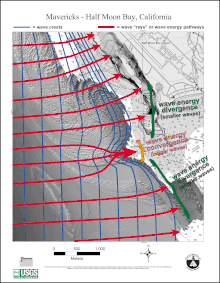Talk:Green's law
A fact from Green's law appeared on Wikipedia's Main Page in the Did you know column on 3 November 2016 (check views). The text of the entry was as follows:
|
| This article is rated Start-class on Wikipedia's content assessment scale. It is of interest to the following WikiProjects: | ||||||||||||||
‹See TfM›
| ||||||||||||||
Why?
[edit]This article discussed the relationship between wave size and depth, but doesn't mention why this might be. Does friction slow the fronts of the waves, so that the backs catch up with them? --Piledhigheranddeeper (talk) 00:52, 3 November 2016 (UTC)
- Hello Piledhigheranddeeper, the process is unrelated to friction (long waves may propagate over very long distances before reaching the coast, without being substantially reduced by friction). When the wave propagates, energy is transferred from one fluid element to its neighbourhood. While the fluid elements only move a bit during the passage of the wave, the wave itself (and the associated energy) may propagate over very long distances (in the ocean thousands of kilometers, for tsunami's and swell). When considering several vertical cross sections perpendicular to the wave propagation direction: the total amount of energy transferred from one side of each cross section to the other side -- due to the passage of the wave -- has to be the same for each vertical cross section (an adiabatic invariant, neglecting friction). As a consequence, the energy flux through each cross section along the path of the wave, until it meets the coast, has to be the same. The energy flux is equal to with the wave energy and the group velocity. According to the linear theory of shallow-water waves (i.e. wavelength much larger than water depth) and Green's law follows.
- Another perspective on the matter is from following a wave: the total energy in a wave is its energy density integrated over the wavelength i.e. for a sine wave When this non-dispersive waves moves into shallower water, its phase speed (equal to the group speed) decreases. This means the wavelength decreases proportional to the decrease in wave speed (see e.g. the animation in the article). Consequently, for to stay constant, the energy density has to increase as . -- Crowsnest (talk) 18:15, 4 November 2016 (UTC)
Unclear description
[edit]In the description section Green's law is stated in terms of H, b and h. H and h are clearly defined. b is defined where the channel is narrow, but the description then goes on to talk about b in terms its interpretation for long waves. Following the link ray leads to an optics page, where rays are effectively arbitrary geometric constructs for analysing lenses etc. So what is "the distance between wave rays"? In the case of a deep ocean swell approaching the continental shelf the "channel width" would appear to be extremely wide, up to thousands of miles.
I'm not a mathematician so tread very carefully here. Would I be right that for a long wavefront the assumption is that the "channel" is effectively constant width and therefore:
and so assuming b to be constant:
and this is the form to be used to allow the prediction of swell heights across a long front?
@Crowsnest: or someone else knowledgeable, if I'm right, please tidy up the above and insert it for non-mathematicians. If, on the other hand, I'm wrong please supply a description for ordinary mortals.
Thanks Martin of Sheffield (talk) 14:01, 4 November 2016 (UTC)

- Hi Martin of Sheffield, your description is totally correct. Regards, Crowsnest (talk) 18:21, 4 November 2016 (UTC)
- Hi Crowsnest, your recent edits have made the article much clearer. The diagram (=1,000 words?) also clears up what you were meaning about the "rays". Thanks for the good work, Martin of Sheffield (talk) 11:59, 10 November 2016 (UTC)
- Hello Martin of Sheffield, tahank you! And many thanks for the questions: without the help of others it is difficult to get clear what are the fuzzy spots. Best regards, Crowsnest (talk) 23:15, 10 November 2016 (UTC)













![{\displaystyle H_{1}\,{\sqrt {b_{1}}}\,{\sqrt[{4}]{h_{1}}}={\text{constant}}=H_{2}\,{\sqrt {b_{2}}}\,{\sqrt[{4}]{h_{2}}}}](https://wikimedia.org/api/rest_v1/media/math/render/svg/4b458f503efce91e3d7f7ec625ec2cf00af1e33d)
![{\displaystyle H_{1}\,{\sqrt[{4}]{h_{1}}}=H_{2}\,{\sqrt[{4}]{h_{2}}}}](https://wikimedia.org/api/rest_v1/media/math/render/svg/fa25a9649aa09db26d60e567ebc978bd19b651fc)